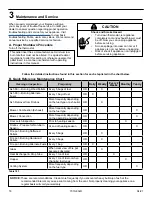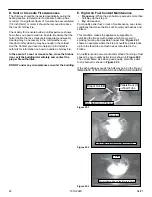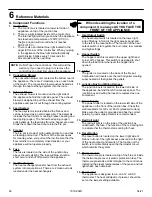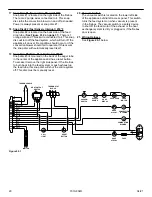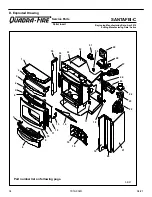
20
04/21
7019-802H
Figure 20.1
Cleaning
Rods
10 Heat Exchanger Tubes
6. Cleaning Heat Exchanger Chambers
• Frequency:
Weekly or every 1 ton of fuel
• By:
Homeowner
T
he amount of ash buildup in the firebox will be a good
guide to determine how often you should clean the heat
exchangers.
a. Allow the appliance to completely cool down before
pulling the cleaning rods.
Turn the thermostat
on and then immediately off to start the exhaust
blower on its cycle time. It will pull fly ash out the
exhaust instead of into the room.
b. Locate the 2 exposed rods directly underneath the
heat exchanger tubes (
Figure 20.1).
c. To clean, pull the rods straight out until it stops,
approximately 8 inches (203mm). Slide the rods
OUT and IN a couple of times.
7. Cleaning Beneath Heat Exchanger
• Frequency:
Monthly or every 1 ton of fuel
• By:
Homeowner
a. Be sure the appliance is allowed to cool, has been
unplugged and the exhaust blower is off.
b. A more thorough cleaning is needed to remove the
excess ash that is left behind from the use of the
cleaning rods for the heat exchanger tubes.
c.
The ash will be resting on the back of the baffle.
This will require removing the cast baffle. Please
refer to page 35 for a detailed explanation of
removing the baffle.
8. Cleaning the Exhaust Path
• Frequency:
Every 25 bags or monthly or more
frequently depending on ash build-up.
• By:
Homeowner
a. Appliance must be completely cool.
b.
Open cast hinge face. Remove baffle and right
brick and thoroughly vacuum the area and continue
throughout the rest of the firebox.
c.
Replace right brick and baffle and close cast
hinge face.
9. Cleaning the Hopper
• Frequency:
Monthly or every 1 ton of fuel
• By:
Homeowner
After burning approximately 1 ton of fuel you will need
to clean the hopper to prevent sawdust build-up. A
combination of sawdust and pellets on the auger reduces
the amount of fuel supply to the fire pot. This can result in
nuisance shutdowns and mis-starts.
a. The appliance must be in complete shutdown.
Allow the appliance to completely cool down.
b. Empty the hopper of any remaining pellets.
c. Vacuum the hopper and feed tube.
NOTE:
Hearth & Home Technologies recommends to
use a heavy duty vacuum cleaners specifically
designed for solid fuel appliance cleaning.
Vacuum
Exhaust Area
Right Brick
Removed
Figure 20.2
WARNING
Heat exchanger cleaning rods may be
warm to the touch. For safety purposes
wear gloves.
Do not pull heat exchanger cleaning rods
while appliance is operating.
Push cleaning rods IN when done, DO
NOT leave cleaning rods OUT. Injury
can occur.
5. Disposal of Ashes
• Frequency:
As needed
• By:
Homeowner
Ashes should be placed in a metal container with a tight-
fitting lid. The closed container of ashes should be placed
on a non-combustible floor or on the ground, well away
from all combustible materials, pending final disposal.
If the ashes are disposed of by burial in soil or otherwise
locally dispersed, they should be retained in the closed
container until all cinders have been thoroughly cooled.
Disposal of Ashes.
• Ashes should be placed in metal
container with tight fitting lid.
• Ashes should be retained in closed
container until all cinders have
thoroughly cooled.
WARNING













